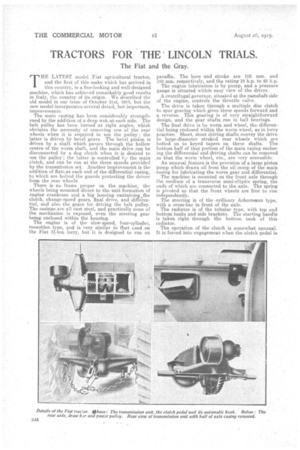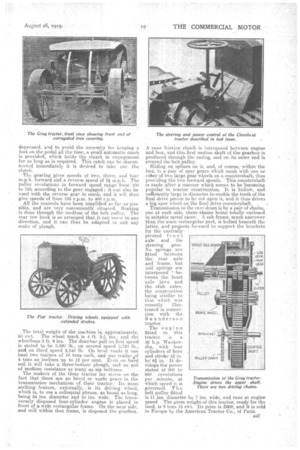TRACTORS FOR THE' LINCOLN TRIALS.
Page 18

Page 19

If you've noticed an error in this article please click here to report it so we can fix it.
The Fiat and the Gray.
T HE LATEST model Fiat agricultural tractor, and the first of this make which has arrived in
. . this country, is a fine-looking arid well-designed machine, which has achieved remarkably goad results in Italy, the country of its origin. We described the old model in our issue of October 31st, 191S, but the new model incorporates several detail, but important, improvements.
The main casting has been considerably strengthened by the addition of a deep web at each side. The belt pulley has been turned at right angles, which obviates the necessity' of removing one of the rear wheels when it is required to use the pulley ; the latter is driven by bevel gears. The bevel pinion is driven by a shaft which passes through the hollow centre of the worm shaft, and the main drive can be disconnected by a dog clutch when it is desired to use the pulley ; the latter is controlled hs the mainclutch, and can be run at the three speeds provided by the transmission set. Another improvement is the addition of fiats:flat each end of the differential casing, to Which are bolted the guards protecting thedriver fram the rear wheels.
There is no frame proper on the machine, the wheels being mounted direct to the unit formation of engine crankcase and a big housing essntaining Jim clutch, change-speed gears, final drive, and differential, and also the gears for driving the belt pulley. The casings. are all cast steel, and practically none of the mechanism is exposedven the steering gear being h :enclosed within the housing. The engine is of he slow-speed, four-cylinder, monobloc type; and is very similar to that used on the Fiat 31-ton lorry, but it is designed to run on
paraffin. The bore and stroke are 105 mm. and 180 mm. respectively, and the rating 18 h.p. to 25 h.p. The engine lubrication is by pump„. and a pressure gauge is situated within easy view of -the driver.
A centrifugal governor, situated at the camshaft side of the engine, controls the throttle valve.
The drive is taken through a multiple disc clutch to spur gearing which gives three speeds forward and a reverse. This gearing is of very straightforward design' and the gear shafts run in ball bearings. The final drive is by worm and wheel, the differential being enclosed within the worm wheel, as in lorry practice. Short, stout driving shafts convey the drive to large:diameter strakcd rear wheels which are bolted on to keyed tapers on these shafts. The bottom half of that portion of the main casing enclosing the differential and driving shafts can be removed .so that the worm wheel, etc., are very accessible.
An unusual feature is the provision of a large piston pump which draws oil froni the oil sump of the main Rasing for lubricating the Worm gear and differential.
The machine is mounted on the front axle through the medium of a transverse semi-elliptic spring, the ends of which are connected to the axle. The spring is pivoted so that the front wheels are free to rise independently.
The steering is of the ordinary Ackermann type, with a cross-bar in front of the axle.
The radiator is of the tubular type, with top and bottom tanks and side brackets. The starting handle is taken right through the bottom tank of this radiator.
The operation of the clutch is somewhat unusual. It is forced into engagemeiat when the clutch pedal is depressed, and to avoid the necessity for keeping a foot on the pedal all the time, a small automatic catch is provided, which holds the clutch in engagement for as long as is required. This catch can be disconnected immediately it is desired to take out the clutch.
The gearing gives speeds of two, three, and four m.p.h. forward and a reverse speed of 2i m.p.h. The pulley revolutions in forward speed range from 100 to 750, according to the gear engaged ; it can also be used with the reverse gear in mesh, and it will then give speeds of from 135 r.p.m. to 400 r.p.m. All the controls have been simplified so far as possible, and are very conveniently situated. Braking is done through the medium 'of the belt pulley. The rear tow book is so arranged that it can move in any direction, and it can thus be adapted to suit any make of plough.
The total weight of the machine is approximately, 53 cwt. The wheel-track is 4 ft. 511 ins., and the wheelbase 5 ft. 9 ins. The drawbar pull on first speed is stated to 'be 5,520.lb., on second speed 3,750 lb., and on third speed 2,540 lb. On level roads it can haul two .trailers of 10 tons each, and one trailer.of 4 tons on inclines up to 12 per cent. Even on hard soil it will take a three-bottom plough, and on soil of medium resistance as many as six bottoms. The makers of the Gray tractor lay stress on the fact that there are no bevel or wn gears in the transmission mechanism of their tractor. Its most striking feature, externally, is its driving wheel, which is, to use a colloquial phrase; as broad as long, being 54 inn. diameter and 54 ins. wide. The transversely disposed four-cylinder engine is placed in front of a wide rectangular frame. On the near side, and still within that frame, is disposed the gearbox.
A cone friction clutch is interposed between engine and box, and thisfirst motion shaft -of the gearbox is produced through the easing, and on its outer end is secured the belt -pulley.
Sliding on splines on it, and, of course, within the box, is a pair of spur gears which mesh with one or other of two large gear wheels on a countershaft, thus providing the two forward speeds. This countershaft is made after a manner which seems to be bqcoming popular in tractor construction. It is hollow, and sufficiently large in diameter to enable the teeth of the final drive pinion to be cut upon it, and it thu-s drives
a big spur wheel on the final drive countershaft. . Transmission to the rear drum is by a pair of chains,
one at each side, thesechains being totally enclosed in suitable metal cases,. A sub frame, much narrower than the main rectangular part, is bolted beneath the ja-tter, and prqjects forward to support the brackets for the centrally
pivoted f r o ii t axleand the steering gear. No springs are fitted between the rear axle and frame, but coil sorin'gs are interposed • between the front axle jaws and the stub axles, the construction being grinilar to
-that which was recently illustrated in connection with the Saunderson tractor.
The engine fitted to this tractor is a 36 h.p. Waukeeabs., with four cylinders of bore and stroke 41 in. by 61 in. It develops the power stated at 800 to 850 revolutions per minute, at which speed it is governed. T h e belt pulley fitted is 11 ins, diameter. by 7 ins, wide, and rtins at engine speed. The gross weight of this tractor, ready for the land, is 2 tons 15 cit. Its price is £600, and it is sold in Europe by the American Tractor Co., of Paris.
Transmission of the Gray tractor. Engine drives the upper shaft. There are two driving chains.
























